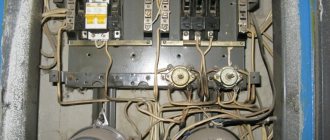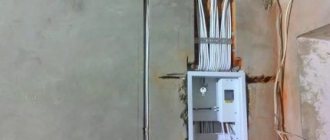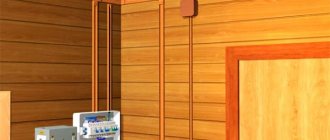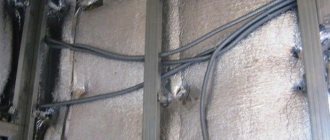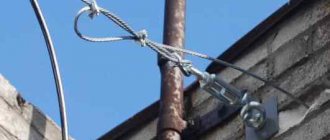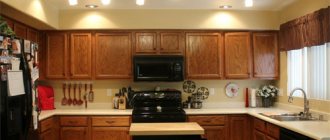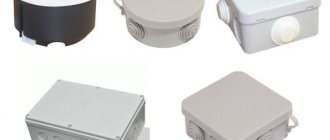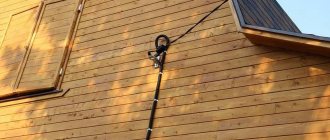In masonry houses with the installation of electrical wiring, everything is simpler, since laying the cable on fireproof foundations does not require additional protective measures. A competent calculation of cable cross-sections (non-flammable) and the presence of electrical protective equipment in the system that corresponds to the loads are sufficient. The situation is different with wiring laid on combustible bases: in order for it to comply with current regulations, much more effort will have to be made. If the house is wooden (frame), the installation of internal electrical networks will be both more difficult and more expensive. But even a stone house is not always possible to get by with “little loss”, because often the ceilings, and even attics and various superstructures in such houses are also wooden or with a wooden frame. Let's look at what rules govern the installation of wiring on combustible foundations, and how FORUMHOUSE participants carry it out.
Wood cable PUE
Installing electrical wiring in a wooden house is a more important undertaking than laying conductive routes in a brick or concrete structure. This is due to the specifics of the material: wood burns, even if it is impregnated with a composition that prevents ignition from an accidental coal.
The importance of correct installation
The temperature of the electric arc, which occurs when a short circuit of conductors carrying a current of standard 220 V, can reach 5000 °C (!). No fire-prevention impregnation helps against the temperature that melts steel.
Despite this, wiring in a log house made of rounded logs or a frame country house is often done “carelessly,” if not carelessly.
This is usually motivated by a reluctance to tinker a lot with the dacha, where they live for two to three months a year.
But you should understand: poorly made internal wiring of a wooden house can leave you without this very house.
Please note that “poor quality” primarily means “not according to the rules provided for a wooden house.” The usual practice of installing a household electrical network in an apartment or brick house is not suitable for a wooden one due to the flammability of the building material .
What the regulations say
The rules for electrical installations - PUE - give a clear answer to this question. Hidden wiring in the voids of partitions made of flammable materials is permissible only in metal pipes that have the property of localization.
SNiP gives a more vague formulation, so it is recommended to be guided by the PUE. By flammable material we mean wood, even if it has fire-resistant impregnation.
Under the metal pipe is a steel or copper pipe of square or round profile, having a regulated wall thickness of at least 2.8 mm for any cable with a conductor cross-section of up to 4 mm.
For cables with a cross section of 6-10 mm, the pipe wall thickness should be 3.2 mm. In this case, it is forbidden to tightly “clog” the pipe with cables - the cable should occupy no more than 40% of the clearance.
To insert a cable from a power line into a wooden house, only a thick-walled steel sleeve is used.
This requirement is due to the following situation.
If a short circuit occurs due to a cable breakdown, only a thick-walled pipe can withstand the flash until it self-extinguishes or the circuit breaker is triggered.
The use of metal hoses or other “armor” made of corrugated metal or plastic for hidden wiring in a wooden house is unacceptable for the following reasons:
- they do not provide localization of the source of a possible fire, since they instantly burn out during a flash;
- they do not protect the wiring from the teeth of mice and rats;
- they do not protect the wiring from damage if the wooden house shrinks.
The main “unofficial” rule for high-quality wiring in log wooden houses is the prevalence of safety over external beauty.
Laying in pipes
Laying wiring in steel or copper pipes, observing the requirements specified above, is possible only at the stage of building a house from scratch.
For example, when installing electrical wiring in a house made of laminated veneer lumber, the installation of a system of such pipes, junction boxes and sockets (also metal) is carried out at the stage of installing the frame.
The rules for hidden wiring of power cables in a wooden house do not allow laying the cable in metal or plastic corrugation in sawn grooves.
Laying wiring in grooves inside the walls of a wooden house in thick-walled pipes is acceptable, but difficult due to the need to bend the pipes and make complex connections using couplings, fittings or welding.
There are a number of requirements that must be met when installing hidden wiring in a wooden house.
The inner surface of steel pipes must be painted or galvanized to prevent corrosion, copper pipes must be painted to protect against oxides. The use of a metal hose/steel corrugation on bends and transitions makes the entire structure meaningless - transitions are provided with threaded connections or butt-to-butt welding.
Horizontally, electrical wiring pipes in a wooden house are laid at a slight angle to allow condensation to escape; at the lowest point, a hole is made for liquid drainage (not inside the wall). The entire system is provided with a grounding connection that is separate from the grounding provided by the wiring.
In wooden houses, only metal sockets are used for sockets and switches.
To avoid damage to the cable sheath by a sharp edge when exiting the pipe, the edge must be rolled or provided with a protective plastic plug.
Open wiring - installation features
If a wooden house has already been built, but there is a need to replace the wiring in it, then this can be done without sawing grooves in wooden partitions, which are often not very thick and strong themselves.
Installation of electrical wiring according to the electrical installation rules (PUE)
Unlike the mass of existing standards in various fields, the PUE is not a new product, but an old-timer - the first edition of the rules dates back to 1946. With the development of technology and stricter requirements for the safety and reliability of electrical systems, these rules have undergone changes over and over again. Today, the “electrician’s handbook” is already in its 7th edition, valid since November 2003 (last changes 2016). But, by and large, this is a modernized version of the 6th edition, introduced into use by the USSR Ministry of Energy in 1985, from which some sections and chapters were removed, and some were added. In particular, we have tightened the requirements for the safety of electrical networks in order to maximally comply with international standards in this area.
According to the PUE, the choice of types of electrical wiring and installation methods is based on fire safety conditions. In table 2.1.3. All possible options are listed.
| Type of electrical wiring and method of laying on foundations and structures | Made from fireproof and flame retardant materials | Wires and cables |
| Made from combustible materials | ||
| Open wiring | ||
| On rollers, insulators or with a layer of fireproof materials | Directly | Unprotected wires, protected wires and cables sheathed in combustible materials |
| Directly | Directly | Protected wires and cables sheathed from fireproof and fire-resistant materials |
| In pipes and boxes made of fireproof materials | In pipes and boxes made of fire-resistant and non-combustible materials | Unprotected and protected wires and cables sheathed from combustible, non-combustible materials |
| Hidden electrical wiring | ||
| With a lining of fireproof materials¹ and subsequent plastering or protection on all sides with a continuous layer of other fireproof materials | Directly | Unprotected wires; protected wires and cables sheathed in combustible materials |
| Lined with fireproof materials¹ | Directly | Protected wires and cables sheathed in flame retardant materials |
| Directly | Directly | The same, from fireproof |
| In pipes and ducts made of non-combustible materials - with lining under the pipes and ducts of non-combustible materials¹ and subsequent plastering² | In pipes and ducts: from combustible materials - enclosed, in grooves, etc., in a continuous layer of non-combustible materials³ | Unprotected wires and cables sheathed in combustible, non-combustible and non-combustible materials |
| The same from fireproof materials - directly | The same from flame retardant and non-combustible materials - directly | Unprotected wires and cables sheathed in combustible, non-combustible and non-combustible materials |
Notes:
¹ A lining made of fireproof materials must protrude from each side of the wire, cable, pipe or duct by at least 10 mm.
² Plastering of the pipe is carried out with a continuous layer of plaster, alabaster, etc., at least 10 mm thick above the pipe.
³ A continuous layer of fireproof material around the pipe (box) can be a layer of plaster, alabaster, cement mortar or concrete with a thickness of at least 10 mm.
Despite the fact that PUEs have been in effect for more than half a century, not everyone understands that they also apply to residential buildings. Thus, to one of the previous articles devoted to methods of installing electrical wiring in houses made of various materials, the following comment appeared:
DmitryIgonin FORUMHOUSE Member
By the way, PUEs have nothing to do with the issue under consideration, since they are intended for industrial facilities. Look at the preamble!
kungurov FORUMHOUSE Member
Excerpt from the PUE:
“The book contains requirements for the installation of electrical lighting in buildings, premises and structures for various purposes, open spaces and streets, as well as requirements for the installation of advertising lighting. Contains requirements for electrical equipment of residential and public buildings, entertainment enterprises, club institutions, sports facilities...”
GOST R 50571.5.52 requirements for external electrical wiring
Standard GOST R 50571.5.52-2011.
“Low-voltage electrical installations. Part 5-52. Selection and installation of electrical equipment. Electrical wiring”, with a few exceptions, establishes requirements for electrical wiring without dividing them into internal and external. We can highlight the most important requirements, which also apply to external electrical installations.
In accordance with 521.6 GOST R 50571.5.52:
— electrical wiring systems in pipes must comply with IEC 61386 (GOST R IEC 61386.1-2014 Pipe systems for laying cables. Part 1. General requirements is in force in Russia);
- electrical wiring systems in cable or special cable boxes - IEC 61084 (GOST R IEC 61084-1-2007 Cable and special cable boxes systems for electrical installations. Part 1. General requirements);
- electrical wiring systems on cable trays and cable ladders - IEC 61537 (GOST R 52868-2007 Cable tray systems and cable ladder systems for laying cables. General technical requirements and test methods).
Chapter 522 GOST R 50571.5.52 “Installation of electrical wiring under external influences” contains important requirements regarding the protection of electrical wiring from moisture, tensile forces on vertical sections of the route from its own weight, displacement of building structures and other mechanical influences.
Chapter 527.1 GOST R 50571.5.52 “Safety measures within a separate fire-restricted room” contains instructions on what standards materials classified as non-combustible must meet so that they can be used without special precautions.
It should be borne in mind that if part of the electrical wiring is located inside the building (for example, in the case of connecting an architectural facade lighting panel to the building's ASU), then all cables laid in the building before they exit to the facade must meet the requirements of Chapter 527.1, as well as the requirements other regulatory documents related to electrical installations of buildings. In this case, all cables laid in the building up to the first branch box located on the facade must meet the requirements of GOST 31565-2012 “Cable products. Fire safety requirements."
Chapter 527.2 GOST R 50571.5.52 “Sealing passages of electrical wiring” contains requirements that must be met in the case of cables being taken out of the room to the facade of the building, as well as for sealing electrical wiring laid in pipes and ducts.
Chapter 528 GOST R 50571.5.52 “Proximity of electrical wiring with other utility networks” establishes requirements for electrical wiring in close proximity to various utility lines.
Part of the requirements of Appendix F directly applies to external electrical wiring. Here are the characteristics for pipes according to the classification according to IEC 61386 (GOST R IEC 61386.1-2014 is in force in Russia). For external electrical wiring, it is recommended to use pipes that have the parameters “Degree of compression resistance” and “Degree of impact resistance” not lower than class 3 (medium) according to GOST R IEC 61386.1. In accordance with the requirements of 6.1 GOST R IEC 61386.1, pipes according to the above parameters are divided into: class 1 - very light, class 2 - light, class 3 - medium, class 4 - heavy, class 5 - very heavy).
At the same time, in Appendix F of the GOST R 50571.5.52 standard there is no division of pipes into metallic and non-metallic, but only the mechanical properties of the pipe are indicated.
Requirements of the GOST R 50571.5.51 standard
GOST R 50571.5.51-2013/IEC 60364-5-51:2005 “Low-voltage electrical installations. Part 5-51. Selection and installation of electrical equipment. General requirements".
At a minimum, this standard must take into account the following requirements:
512.2.1 Electrical equipment shall be selected and installed in accordance with the requirements of Table 51A, which specifies the required characteristics of electrical equipment appropriate to the external influences to which it may be subjected.
512.2.2 If the electrical equipment by its design does not meet the requirements that satisfy external influences at the installation site, then it can be used with the installation of appropriate additional protection when installing the electrical equipment. Such protection must not have a harmful effect on the functioning of the electrical equipment.

